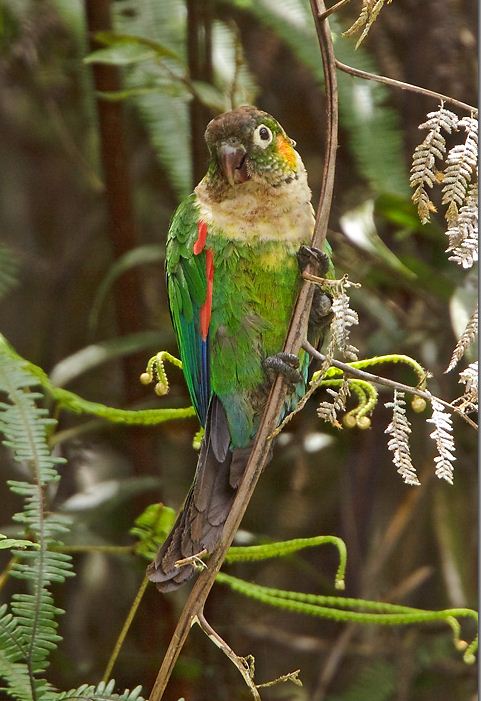Content |
|---|
Description:
24 to 25,5 cm.. height.
The most notorious of the White-necked Parakeet (Pyrrhura albipectus) It is the yellowish-white or white that goes from the cheeks to chest.
Crown dark stripes pale gray on the back; frontal band reddish thin; cheeks escalations of yellow and green and ear-coverts Orange; collar full white and chest yellow; belly and remaining upperparts green. Wings Greens with primary coverts red and carpal area, and primaries Bluish; tail long and pointy green, red opaque at the bottom.
The immature lacks the frontal band and has paler the ear-coverts.
- Sound of the White-necked Parakeet.
Habitat:
|
|
|---|
Lives mainly in humid primary forest, foraging on fruit trees, preferably along rivers, Although he tolerates areas open and intercepted, from 900 to 2000 m (usually between 1400 and 1800 m).
Make altitudinal movements following the fruiting. Flies in flocks of 12 to 50 individuals. It bathes in pools or between rocks covered with MOSS.
Reproduction:
There is little evidence about its reproduction, possibly from May to July. A young clerk was seen in September (Snyder et to the., 2000).
Food:
The diet includes fruit, seeds and flowers Vine, mainly taken in the canopy.
Distribution:
Size of its range (reproduction / resident): 19.600 km2
Confined to three areas in southeast Ecuador and recently also it has been found in northern Peru.
In Ecuador It is known from the Podocarpus national park, the Cordillera de Cutucú and Cordillera del Condor. Although their numbers seem relatively low, possibly with a total population of only a few thousand individuals, is apparently common in the Podocarpus national park. There are also confirmed records as far south as the Pangui in Zamora-Chinchipe. Also recently it observed in adjacent parts of the Cordillera del Condor, Peru, with a sighting released from Condor Mirador on Morona-Santiago Province (Navarrete 2003). These range extensions suggest that it is not as severely threatened as previously feared. (Balchin y Toyne 1998).
Conservation:
State of conservation ⓘ |
||
|---|---|---|
 Vulnerable ⓘ (UICN)ⓘ
Vulnerable ⓘ (UICN)ⓘ
| ||
• Current category of the Red List of the UICN: Vulnerable.
• Population trend: Decreasing.
Rationale for the Red List category
This species is classified as Vulnerable because it dwells in a few places and has a small range in which the habitat (and presumably the population) it is decreasing.
Justification of the population
The total population it may be only a few thousand birds, by what is placed in the band 2.500-9.999 individuals. This is equivalent to 1.667-6.666 mature individuals, rounded here to 1.500-7.000 mature individuals.
Justification of trend
It is suspected that the species is falling slowly, on the basis of continuous habitat destruction.
Conservation Actions Underway
• CITES Appendix II.
• The Podocarpus national park It is an important site for the conservation of the species. A revised management plan has been designed for the area and a public awareness campaign highlights the importance of the park (Snyder et to the. 2000).
• The White-necked Parakeet It is also found in the reserve Tapichalaca of 3.500 acres of the Fundación Jocotoco, where they are used successfully artificial nesting boxes (Waugh 2009).
• It is also located in the Ichigkat Muja- Condor Range National Park (F. Angulo 2012 a bit.).
Conservation Actions Proposed
• Conduct surveys to assess species distribution and total population size.
• Monitor rates of habitat loss and degradation within its range.
• Manage the Podocarpus national park so that endangered species are better protected.
"White-necked Parakeet" in captivity:
It is not easy to find it in captivity.
Alternative names:
– White-necked Parakeet, White necked Parakeet, White-breasted Conure, White-breasted Parakeet, White-necked Conure (English).
– Conure à col blanc, Perriche à col blanc, Perruche à col blanc (French).
– Weißhalssittich, Weisshals-Sittich (German).
– Tiriba-do-pescoço-branco (Portuguese).
– Cotorra Cuelliblanca, Perico de Pecho Blanco (español).
– Perico de Cuello Blanco (Peru).
scientific classification:

– Order: Psittaciformes
– Family: Psittacidae
– Genus: Pyrrhura
– Scientific name: Pyrrhura albipectus
– Citation: Chapman, 1914
– Protonimo: Pyrrhura albipectus
Images White-necked Parakeet:
Videos "White-necked Parakeet"
|
|
|---|
White-necked Parakeet (Pyrrhura albipectus)
Sources:
– Avibase
– Parrots of the World – Forshaw Joseph M
– Parrots A Guide to the Parrots of the World – Tony Juniper & Mike Parr
– Birdlife
– Parrot Book, Parrots and macaws Neotropical
– Photos:
(1) – Ingrid Grunwald, IBC943789. Photo of White-necked Parakeet Pyrrhura albipectus at Zamora-Chinchipe Province, Ecuador. Accessible at hbw.com/ibc/943789.
– Sounds: (Xeno-canto)





